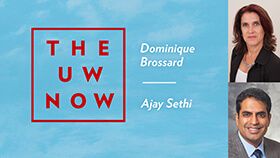As America heads into the holiday season, the number of COVID-19 cases is on the rise. Though some people are feeling lonely and isolated, public health professionals warn that gatherings of families and friends could become super-spreader events. People around the country are trying to figure out how to accurately assess their pandemic risk this holiday season. Is it safe to get together or not?
“As an epidemiologist, I have to respond with the answer all epidemiologists give,” says Professor Ajay Sethi, director of the UW’s master of public health program, “which is that it depends.”
Assessing Your Holiday COVID Risk
Sethi joined Dominique Brossard, chair of the UW’s Department of Life Sciences Communication, to discuss coronavirus risk on The UW Now Livestream on December 8.
Sethi confessed that he’d spent Thanksgiving with his parents in Maryland, though he emphasized that he had been with them for 10 weeks and does his work remotely. He noted that small gatherings — two or three people who know each other well — are inherently safer than large gatherings, but he also said no gathering can be completely safe.
“The only way to achieve that level of assurance [of safety] is for every individual getting together to have essentially eliminated their chance of bringing the coronavirus to that gathering,” he said. “And it is a tall order.”
Perceived Risk versus Actual Risk
Brossard argued that people will make their holiday decisions based on how they perceive risk — and noted that perceived risk is different from actual risk. People tend to perceive a relatively low level of risk from coronavirus because they haven’t experienced the illness firsthand. To make decisions with greater awareness of the danger of COVID-19, they should work to imagine its potential for personal harm.
“The best way for us to think about decisions we’re going to make during the holidays,” she said, “is actually how a doctor put it very recently in a news item: imagine yourself in that ICU room, and imagine yourself in that bed.”
Brossard and Sethi each gave a brief presentation and then took questions from viewers who followed the event live on YouTube. Mike Knetter, president and CEO of the Wisconsin Foundation and Alumni Association, hosted the conversation and served as moderator. Ultimately, Brossard said, we will make the best decisions when we consider not only the risk we take for ourselves but try to gauge the risk we might inflict on others. “We can take a step back and realize that we are social animals,” she said.
To hear more from the speakers, view a recording of The UW Now. The series is offered via YouTube, and the next event will be December 15.
